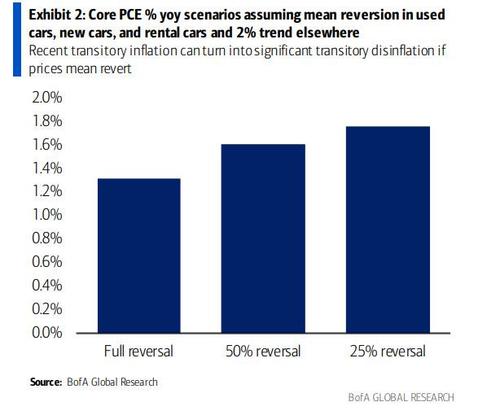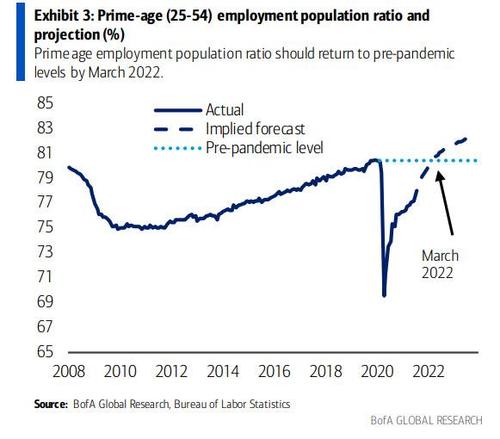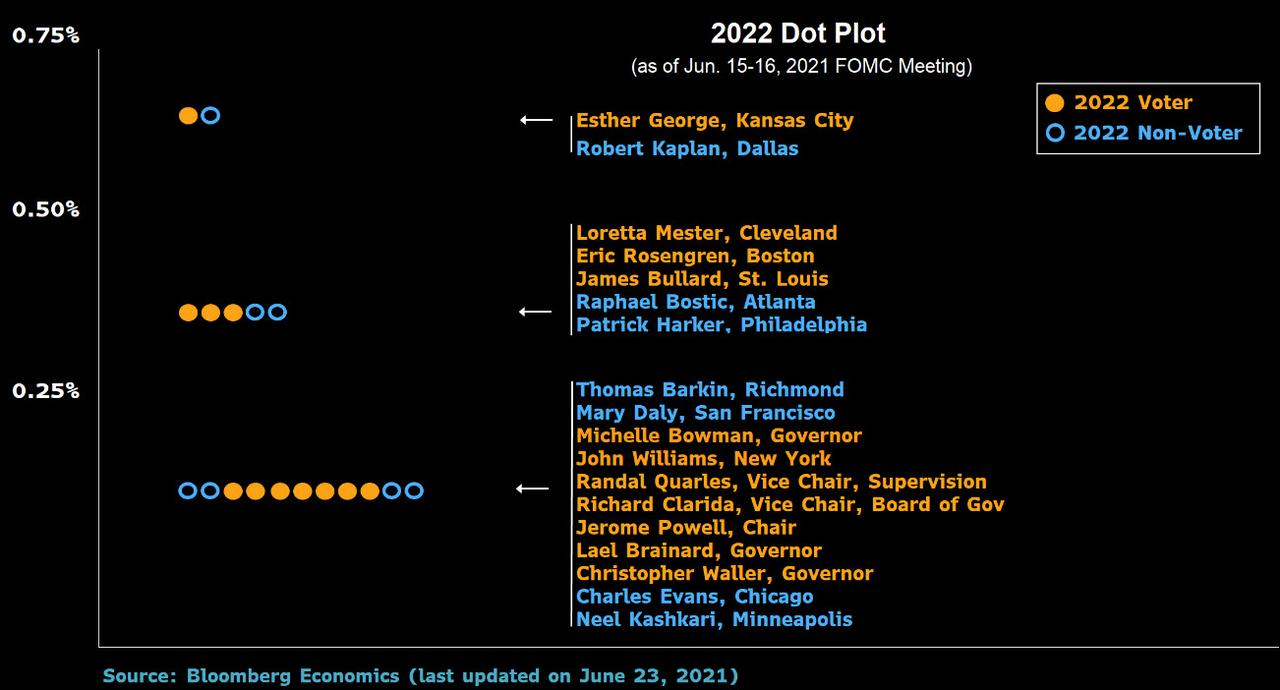The Fed's Complete Taper Timeline
Commenting on the Fed's recent communications debacle, Bank of America economist Michelle Meyer writes that the Fed was getting high marks for its communication "up until the last meeting where the message got jumbled". Specifically, in light of the stunned market reaction following the last meeting, many commentators declared that the Fed had abandoned Flexible Average Inflation Targeting (FAIT), which Meyer strongly disagree with, conceding that while a growing number of Fed officials have become uncomfortable with rising inflation and are looking to remove accommodation faster, the reality is that Chair Powell and the majority of the Committee have not given up on FAIT. Indeed, Meyer notes, "the gut reaction of the markets pulling forward rates hikes to 4Q 22 following the last meeting proved fleeting as the market has subsequently pushed out the first hike back to 1Q23."
To help navigate the Fed's communication error, Meyer provides a guide for understanding the Fed’s (latest) reaction function and communication.
First, the Taper
Here Chair Powell has been crystal clear: the Fed will slowly guide the markets toward the taper. BofA shows the taper timeline in the chart below, with its expectations overlaid.
(Click on image to enlarge)

While Meyer concedes that it is possible for the Fed to signal tapering at the upcoming meeting in July, the BofA economist remain doubtful. The reason to wait is that the market isn’t pricing in the announcement at this meeting, and the Fed wouldn’t want to risk surprising the market. In the last meeting, Powell stated that taper was still “a ways away”. But on the other hand, they have been providing hints that an earlier move is possible, and the surprise will be minimal. Financial conditions are also very accommodative with yields significantly lower making it less painful if rates reset higher upon a taper announcement. Combining these two, BofA thinks it is much more likely that they signal in September.
There is also a risk of the Fed pulling forward the actual taper from BofA's current forecast of January to perhaps December or even November. This depends on how much quantitative guidance the Fed offers along with the taper signal. According to Meyer, if the Fed is clear that they want to see a certain amount of job creation in order to taper - such as a range for the employment-to-population ratio or progress on the jobs deficit - it will be easier to wait to execute taper. Another option would be to offer calendar guidance but this seems to run counter to Powell’s desire for policy to be “outcome based” rather than “outlook based.” If the Fed keeps the language vague arguing for “substantial further progress”, it seems to leave options open.
What about hikes
The Fed laid out the criteria to hike rates as three-fold:
- inflation needs to reach 2% and stay there for a year;
- conditions be met to believe that inflation can run moderately above 2% allowing for the overshoot to offset the undershoot;
- maximum employment to be met with broad-based labor market recovery.
The first has been satisfied. We are on the way to meeting the second, although doubts remain - especially among the FOMC - given the potential transitory nature of inflation. The third criteria hasn’t been satisfied and also a likely needed for the second to be met.
The challenge, as Meyer explains, with declaring victory on the inflation overshoot is that we are vulnerable to inflation falling back below the target – at least temporarily – next year. For simplicity, let’s focus on the biggest source of transitory inflation: vehicles (defined here as used cars and trucks, rental cars and new vehicles). This makes up around 5% of core PCE. Over the last two months, about 40bp of the 1.2% gain in core PCE owed to these categories. To put this into perspective, if these categories were unchanged, core PCE would have been 0.48% mom in April (2.9% yoy) and 0.31% in May (3.0% yoy). For illustrative purposes, BofA also ran scenarios for %yoy core PCE inflation through next year based on the following paths for car prices: full mean reversion to preCOVID levels, 50% reversal, and 25% reversal, assuming trend core inflation of 2.0% in all other categories. This would lead to core PCE of 1.3%, 1.6%, and 1.8%, respectively, as shown on the chart below. This shows the sensitivity of inflation to a singular volatile category.

The path toward maximum employment is also uncertain for two reasons:
- it is unclear how much of the decline in the labor force will prove permanent; and
- the Fed has changed the definition of maximum employment.
For the former, BofA has previously estimated that the vast majority of those that dropped out of the labor force will be able to return with about half of the decline likely directly attributable to the pandemic. However, about 1.2 million reflects earlier retirement which is unlikely reversible. This will make it more challenging to fully recover the employment-to-population ratio (EPOP). Perhaps a work-around is to look for the prime-working age EPOP to return to pre-pandemic levels which can be achieved by March 2022 based on BofA's employment forecasts which currently is looking for a cumulative 5.9mn jobs to be created by 1Q 2022.

The other consideration mentioned by BofA, is that the Fed has changed its definition for maximum employment to be broad-based and "inclusive." This means that the recovery in the EPOP has to be felt throughout the population particularly for the most economically challenged cohort, i.e., no hikes until there is a surge in black employment. To achieve this, it will require an even tighter labor market where the “fringe” of the labor market is offered greater opportunities. This in particular calls for the prime-age EPOP to exceed pre-pandemic levels, further pushing out when the Fed might declare victory. And since it is the minority workers who have repeatedly stated they will not return to the labor force unless they get far more preferential terms, it is almost as if the Fed has engineered the current reaction function to one where it will continue to ease indefinitely and blame lack of "recovery" on black jobs for its refusal to stop the easing, as if injecting $120BN per month will somehow result in more black workers getting hired!
The Committee: divided
Last but not least, there is a growing divide on the Committee which complicates forward guidance. As of the June meeting, there were 7 FOMC officials who expected hikes to start in 2022. According to BofA, all of these officials are regional Fed Presidents, some of whom have never fully embraced FAIT (below is Bloomberg's assumption of who is who on the dot plot).
(Click on image to enlarge)

And so, with the economy running strong and inflation pressures building – at least on the surface – these Fed officials are getting ready to remove accommodation. As BofA notes, this makes sense.... if you are still operating in the old regime: remember that the Fed hiked rates for the first time with core PCE inflation well below target. The view was that it was preferable to slowly normalize policy based on expectations of future inflation and growth to avoid having to hike quickly and destabilize the recovery. Hence the challenge with keeping the new framework “flexible”. BofA believes the “core” of the Committee – Powell, Brainard and Clarida – are much more influential in setting the course for policy. The Board of Governors and NY Fed President Williams will generally be in agreement. It is this group that is still strongly committed to FAIT with more than a token overshoot of the 2% target, preferring to err on the side of too much rather than too little inflation. Moreover, they might not be as concerned about higher inflation: indeed, the Board staff forecast shows a slower trajectory for inflation based on the latest FOMC minutes. The Committee members’ voices will be heard and can influence the decisions of the FOMC with the force of their arguments. As such, Meyer's advice is to pay more attention to the centrist members of the FOMC – such as Bostic and Harker – whose arguments could resonate with the Board.
Finally, markets, where we have seen big moves in rates
The bond market has had a significant rally; at 1.30% the 10-year is back to mid-February levels. In fact, the curve has also flattened significantly in a way that typically doesn’t happen until the hiking cycle has started. So what gives? According to BofA's in house rates expert, Mark Cabana, the move is partly technical, driven by investors closing out short positions and trend-following hedge funds exacerbating rate moves. But it could also reflect the market becoming increasingly worried about structurally lower growth and inflation once the cyclical lift fades. It may also be that the market is doubting the Fed’s resolve to overheat the economy and facilitate higher inflation. For what it's worth, Meyer says that while the former is a reasonable argument, she strongly disagrees with the argument that the Fed has already blinked. That's because Powell has been setting the stage for this new framework even before the pandemic - which was a welcome catalyst to implement FAIT - and sees this as a chance to reset monetary policy.
In short: expect the flood of liquidity to continue for a long, long time.
Disclaimer: Copyright ©2009-2021 ZeroHedge.com/ABC Media, LTD; All Rights Reserved. Zero Hedge is intended for Mature Audiences. Familiarize yourself with our legal and use policies every ...
more


